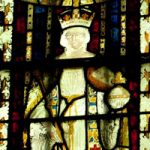The village of Oswaldkirk takes its name from this parish church of Saint Oswald, the Christian king of Northumbria, who invited Saint Aidan to establish the monastery of Lindisfarne and was slain in 642 fighting against the heathen king Penda at Maserfield. Nothing now remains of the earliest, wooden, Saxon church, but the nave of the present church is basically Norman with later insertions. It is possible that there was some rebuilding in the 13th century because the church had to be re-consecrated in August 1287 by Henry, Bishop of Candida Casa (Whithorn), acting under a mandate from the Archbishop of York, John le Romeyn.
The Norman doorway in the North wall, now blocked but visible both inside and outside the church, and the narrow slit window to the West, both survive from the 11th or 12th century.
The large windows in the North and South of the nave were inserted about 1320-1330, and the apices of two of them contain fragments of medieval glass. The three tall arches at the West end were rebuilt between 1800 and 1850, replacing similar, lower arches which hid the small West window. The arched recess in the South wall no doubt contained the tomb of one of the Pickering family, Lords of Oswaldkirk from the 14th to the 16th century.

Likewise, the weathered West Window, which portrays Queen Victoria. The tombstone lying on its side is probably that of Sir Richard Pickering who died in 1441, wishing to be buried before the altar of Our Lady, where the pulpit now is, and leaving his green coat to be made into a vestment for Saint Oswald’s altar.
The pulpit is 17th century. The bell tower is from the 19th century and contains two bells inscribed VENITE EXULTEMUS DOMINO 1684 and GLORIA IN ALTISSIMUS DEO 1683.
The chancel and much of the woodwork in the chancel is 19th century. The church was substantially restored in 1886. The East window dates from this time and shows Saint Oswald, Saint Cuthbert and Saint Aidan. Likes in the sanctuary and the South side of the chancel are 17th century.The gravestone of a Cistercian abbot lies in the North East corner of the sanctuary. This lay directly in front of the altar until 1886. Whether an abbot of Byland or Rievaulx is buried here is not known, or the stone may have been brought to Oswaldkirk at the Dissolution of the Monasteries. There is a blocked up priestÕs door in the South side of the chancel, and on the outside a 13th century cross can be seen on a re-used stone, together with some primitive sundials.

In the porch there are fragments of Anglian or Danish carving, and other stones. The clock mechanism is dated 1898. The parish registers exist continuously from 1538 and the names of the Rectors of Oswaldkirk are known almost completely from 1320 to the present day. The Living of Oswaldkirk is an ancient Rectory which was in the possession of the Oswaldkirk Pickerings from about 1316 to the end of the 16th century. It remained in private hands until 1980, when the Feversham family passed on their rights to the Archbishop of York. In 1958 the Living was united with that of Ampleforth, the Living of Gilling was incorporated in 1986, and that of Stonegrave in 1998.


